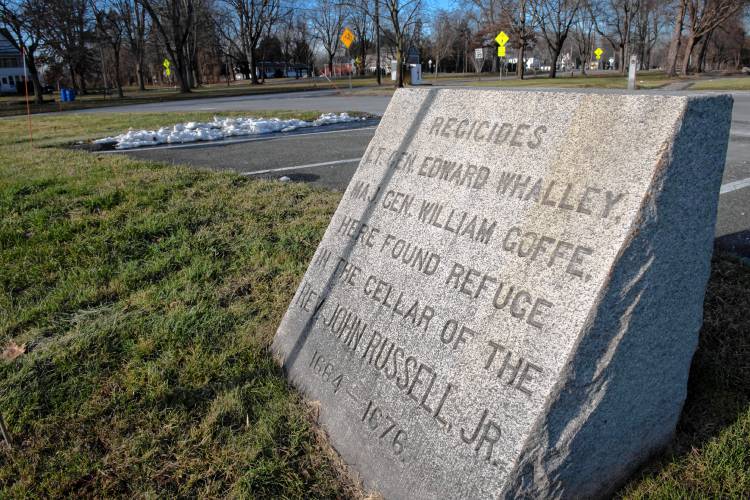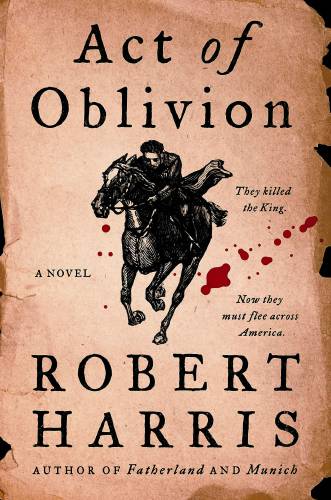By STEVE PFARRER
Staff Writer
Robert Harris is the author of a slew of bestselling thrillers and historical novels, covering ancient Rome, World War II, contemporary politics and more. According to one count, he’s sold over 10 million copies of his books, a number of which have been made into films and TV dramas.
So for his newest book, “Act of Oblivion,” the British writer has turned his attention to the drama and excitement of … colonial Hadley.
“Act of Oblivion” is actually another fine historical novel from Harris, but unlike most of his other books, the action unfolds more slowly, covering a period of almost three decades. It’s also the first time the author has set one of his stories in North America.
With the new book, Harris focuses on two figures of interest in both local and English history: the Puritan military leaders Edward Whalley and William Goffe, two of the men behind the beheading of England’s King Charles I in 1649.
Whalley and Goffe — Goffe was Whalley’s son-in-law — had served with Parliament’s forces in the English Civil War (from 1642 to 1649) against the Royalist army of King Charles. After the Royalists were defeated, Charles was executed, and Whalley and Goffe were among 59 judges, Parliament members and military leaders who signed his death warrant.
But when the monarchy was restored in 1660 under the former king’s son, Charles II, many of those 59 “regicides” were arrested and publicly executed in gruesome fashion. As local history buffs know, Whalley and Goffe fled from England and eventually found refuge in Hadley, at that time on the western edge of English settlement in Massachusetts.
In “Act of Oblivion,” Harris has fleshed out the known facts of the two men with what he calls “imaginative re-creation” to profile their flight to New England and their struggle to keep ahead of their pursuers, who are determined to bring them bring them back to England for punishment — or kill them in America.
One invention by the novelist is the character of Richard Nayler, a member of King Charles II’s Privy Council, who in 1660 leads the effort to hunt down the regicides; he has a particular animus against Whalley and Goffe, revealed through a scene that flashes back a number of years.
“I suspect there must have been such a person” as Nayler, writes Harris. “(Y)ou cannot sustain a manhunt without a manhunter — but whoever he was, his identity has been lost to history.”
And Harris also humanizes these characters — the hunted and the hunter — making the novel both a thriller and a study of political dissent and its consequences.
The story opens in summer 1660 with Whalley and Goffe in Cambridge, Massachusetts, at that point a small settlement with a “confident, two-story timbered property” known as Harvard College. They stay in the home of a fellow Puritan, Daniel Gookin, and in general find plenty of welcome from other Puritans in Boston and Cambridge.

This marker near the corner of West Street and Route 9 in Hadley marks the site of a home where English fugitives Edward Whalley and William Goffe hid for about 12 years during the settlement’s early days. STAFF PHOTO/CAROL LOLLIS
But when Charles II issues a warrant for Whalley and Goffe’s arrest, the two men begin a wandering odyssey that over the next four years will take them to New Haven, Connecticut, some surrounding villages there, and then to Hadley.
They hide in people’s homes, barns, and cellars and also live rough in the woods beyond New Haven; they’re nearly caught at a couple points by a troop of soldiers led by Nayler. It seems a barren existence: Whalley, in his 60s, and Goffe, in his 40s, have left their families behind and would seem to have little hope of ever seeing them again.
Yet both men have a steadfast belief in God and that their exile is simply part of the Almighty’s plan. They’re convinced, Goffe in particular, of the righteousness of their past actions and that they’ll join their loved ones in the next life if they don’t see them again in this one.
“Act of Oblivion” also follows the lives of the implacable Nayler and of others back in England, like King Charles and his brother, the Duke of York, libertines whose main interest is sleeping with as many women as possible.
Meantime, Goffe’s wife, Frances, lives in poverty in London with her five children; she’s forced to move regularly to hide from Nayler and his men, who are trying to track her husband through her.
Time of turmoil
Aside from the intrigue and suspense of the search for the regicides, one of the novel’s strengths is the portrait it draws of England during this chaotic, divided time, including two disasters in the early 1660s: a renewed outbreak of bubonic plague and then a devastating fire in London.
Looking back at battles during the Civil War, and then at the years between 1649 and 1660 when the country was mostly ruled as a protectorate by Oliver Cromwell, the leader of Parliament’s armies, Harris also raises the question of whether Cromwell and his fellow Puritans, with their rigid religious beliefs, were in their own way any less despotic than King Charles I.
Once the fugitives are hiding in Hadley, in the home of the town’s minister, John Russell, Whalley begins to question his role in that past, wondering if he’s really on the right side of history and whether Cromwell — one of his cousins — had been honest with him about his goals for transforming England into a country not under the absolute rule of one man.
“One could never be sure with Oliver,” Whalley considers. “Ambition and godliness, self-interest and the higher cause, the base metal entwined with gold.”
As the years pass, the numbing, utter isolation the two regicides experience, stranded on the edge of the raw American wilderness, begins to magnify Whalley’s doubts, in turn driving a wedge between him and his son-in-law, a division that grows when a third regicide, John Dixwell, joins the two in Hadley for a time.
Goffe, for instance, is convinced the lord will return to earth in 1666 to smite Charles II and their other enemies, allowing him and Whalley to return to England. But as 1666 ends with nothing changed, Whalley has had enough: “I have no faith left in your prognostications,” he says to his son-in-law.

This circa 1850 painting by Frederick Chapman recounts the “Angel of Hadley” story in which William Goffe reportedly helped save the colonial settlement from an attack by Native Americans in 1675-1676. Image from Forbes Library/public domain
As Harris noted in a video interview a few months ago, Whalley and Goffe were “an excellent example” of the political and religious divisions that had existed among Parliament’s forces, which in turn allowed the monarchy to be restored in 1660: “You have the moderate, Edward Whalley, an older man, and you have the firebrand radical, Goffe.”
“Act of Oblivion” also includes the famous “Angel of Hadley” story from 1675 to 1676, in which an unknown man — presumably Goffe — reportedly warned the settlement’s residents that an attack by Native Americans was imminent, then helped hold off that assault.
Though Whalley is believed to have died sometime around 1674 to 1675, nothing is known about Goffe’s end, so Harris uses that uncertainty to create a dramatic finish to “Act of Oblivion.”
A bit romanticized? Perhaps — but it seems a worthwhile conclusion to a thoughtful novel that, as one reviewer writes, “shows the power of forgiveness and the intolerable burden of long-held grudges.”
Steve Pfarrer can be reached at spfarrer@gazettenet.com.



